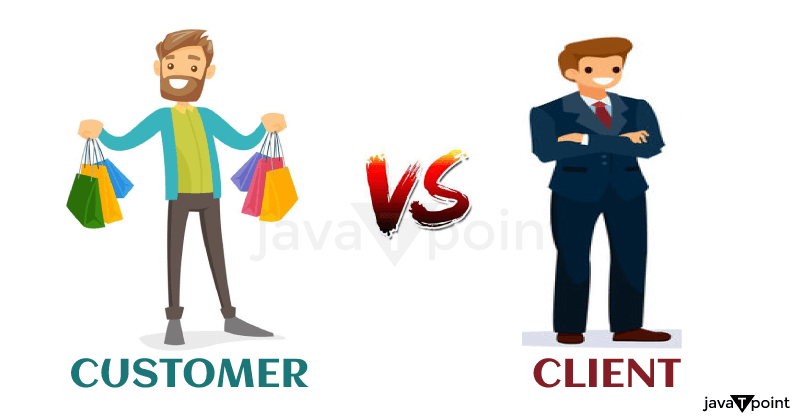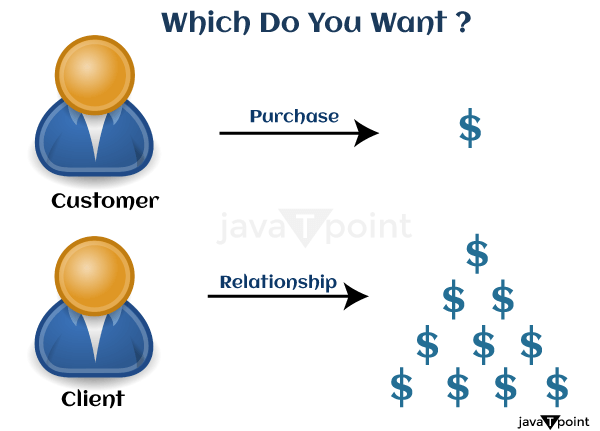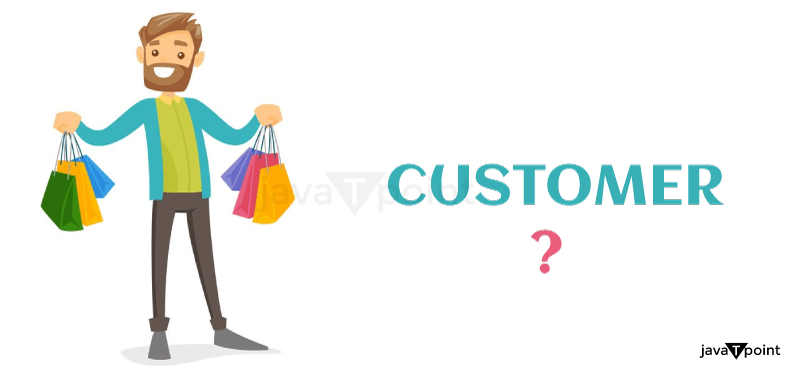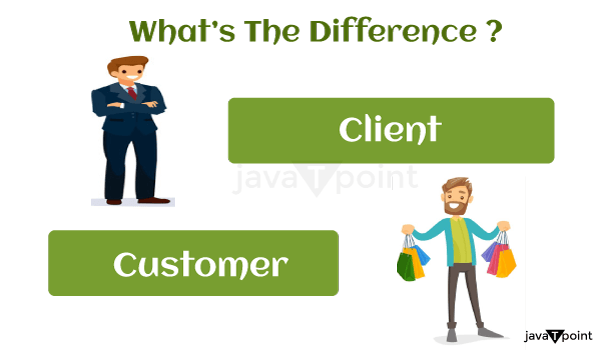Difference Between Client and CustomerA client is a specific customer who gets expert services from a company, whereas a customer uses a company's goods or services. 
Let's review a few instances below to help you understand how the various service types vary. A business with a customer service department typically serves customers rather than clients. Companies without a customer service division are frequently client-based businesses. It's crucial to remember that certain businesses may have clients and customers. Customers with a personal customer success manager (CSM) from your team may acquire professional services from subscription-based businesses like SaaS providers. These are the high-value clients who become your customers. Customers, not clients, have not purchased a professional service from your business. Customer Vs. ConsumerA consumer is a sort of customer who purchases products or services for personal use, as opposed to a customer who purchases a company. While a customer can transact from a B2C or B2B firm, consider consumers the more particular customer for B2C businesses. Consider it this way: Customers may not have bought a product, but consumers are the ones who use it in the end. Customers, clients, and consumers all exist in some businesses. This is why the terms are frequently used synonymously and readily confused. A nice illustration is a bank. A person might enter the building but does not have a bank account there. He does, however, have a check from a bank client that is made out to him. He wants to cash a check made out to him by someone who has a bank account but is not a customer of this bank because they don't interact with each other. Then there is the bank customer who may have substantial savings deposits, business accounts, and loans with the bank; this person is probably familiar with at least one bank representative by first name and has had extensive discussions about his long-term banking needs. Turning Customers Into Clients
There are numerous ways in which businesses of all sizes can develop stronger bonds with customers, converting them into clients. The degree to which your business can win over more devoted customers will determine how well it stands out from and outperforms the competition. For instance, retailers like Starbucks and Nordstrom are effective at fostering customer loyalty through creative rewards programs that use smartphone technology to become more individualized for each customer. A retailer can respond with personalized recommendations and unique product and service deals tailored to meet specific customers' needs by frequently maintaining direct contact with them and soliciting their feedback. Long-term relationships grow stronger when a retailer sees itself as a product agent for every customer. 1. A Question of LoyaltyCustomers may be one-time or recurring customer but rarely show loyalty to the business offering the goods or services. Retail establishments, eateries, gas stations, supermarkets, banks, and amusement parks commonly refer to their patrons as customers. The fixed-form goods and services are priced to sell and satisfy the customers' needs. Patrons are frequently considered to be clients in situations where goods or services require extensive personalization and customization. Over time, clients and business relationships grow closer with businesses that provide clients with ongoing advice and specialized solutions, including law offices, graphic design studios, talent agencies, accounting firms, healthcare providers, and matchmaking services. 2. Customers Buy on Price and ValueCustomers may not always be end users or consumers, but they do pay for purchases. For instance, a customer might purchase a gift from a department store for his spouse, making him the customer and his wife the consumer. Advertising meant to attract new customers often focuses on price and value. Advertising that is directed at consumers frequently places a strong emphasis on effectiveness and quality. Customer-based businesses want people to place online orders, visit them for food, or shop there. 3. Clients Buy on Experience and TrustPromotions intended to attract new clients tend to concentrate on a company's image and expertise in handling issues comparable to those of the prospective client. A law firm will promote its years in business and its trust in obtaining outcomes for clients, in contrast to a store that may publicize cheap costs and a large variety of products. Client-based businesses present themselves as individuals who hope to persuade potential customers to employ them and, ultimately, recommend others. 4. Clients Care About Experience and ReliabilityOn the other hand, you must emphasize your company's reputation and experience in solving issues comparable to the potential clients to draw in new customers. Consider how a supermarket may promote its low costs and the high quality of its fresh produce, but a legal firm might promote its many years of experience in the area and its confidence in obtaining favorable outcomes. Now it makes sense, right? As a result, you must market yourself as a company that wants to persuade potential clients to work with them and, as a result, to suggest others to them. Tips on How to Turn Customers into ClientsBusinesses that cater to consumers and customers typically carry out lone transactions and infrequently forge close bonds with those who pay for their goods and services. Some businesses want to convert transient customers into loyal customers. Loyal customers become clients when they frequent a particular establishment frequently, carry out repeated transactions, and form bonds with the proprietors or employees. Businesses that put resources into converting customers into clients understand that retaining an existing customer could be simpler than acquiring a new one. A more consistent revenue stream than relying on new clients may result from serving a group of recurring consumers. The following advice can help you convert customers into clients: 1. Provide Attractive IncentivesOffer incentives like free consultations and personalized samples to entice current clients to return and make repeat purchases. For instance, a beauty salon may convert one-time guests into regular customers by providing free manicure services. This might entice repeat business from current clients and urge them to return often. 2. Provide Excellent Customer ServiceHigh-quality service providers may have ongoing business with their clients. They are more inclined to make additional purchases and promote these businesses to others when they experience good service. For instance, a grocery store manager who addresses customers by name is likelier to forge strong bonds with them and transform them into steadfast consumers. 3. Maintain Regular CommunicationBusinesses that pay attention to their customers' thoughts and requirements should expect greater repeat business. As if you were serving clients, communicate with them frequently and address their needs. Show that you comprehend their needs by making individualized offers or discounts. To turn customers into clients, successful firms build personal relationships with their customers. 4. Ensure Product or Service QualityYour product's or service's quality directly impacts your customers' purchasing choices. Make sure the goods and services you provide are of consistently high quality. Customers are more likely to make repeat purchases when they know they can count on high-quality goods and services each time they do business with you. 5. Adopt a Relational Selling ModelA relational selling approach tries to create enduring connections with the clients who generate income for your company. In contrast, a transactional selling approach places more emphasis on making quick transactions. When you practice relational selling, your customer's needs come before yours. The likelihood that customers will become clients is higher for successful businesses in relational selling. Why Is Client vs. Customer Important?As a business expands, there are more ways to refer to the customers who use your services or goods. Everything is essentially the same for clients, customers, users, subscribers, and consumers. One of the biggest enigmas in the corporate world is the "client vs. customer" conflict. There are many publications on "client versus customer," people continue to post this query on Quora, but there is still no resolution. It is crucial to your company plan in the SaaS sector. Since customers are the ones who will generate money for your business, these relationships will need extra consideration, more time, and attention, which also means more resources will be devoted to ensuring the success of your customers. Customers would drive customer retention and give you additional chances for upsells and cross-selling. Characteristics of Customers
A broad subject is customer characteristics. However, you must know your clients' fundamental traits to create a customer relationship management (CRM) system. You can collect and store customer information using the CRM system. You must thoroughly know your clients' traits to use your CRM to its full potential. 1. They Might Come and Go Pretty QuicklyFor illustration purposes, let's pretend you have been managing a coffee shop for a while. Before you know it, you're bringing in a steady stream of a few hundred regular clients who stop by every morning before they dash off to work. They may even follow a routine that they never alter. Maybe some buy a mocha with whipped cream daily, which costs about $200. Being in this circumstance is fantastic. Your consumers consistently place the same orders, so you know exactly what they'll get. They even sit at the shop's focal point, their preferred booth or chair. This is essentially guaranteed money you can depend on; it's more than just a source of income. But if the customer's circumstances change, it might not last. 2. StraightforwardThese customers don't stall or make excuses when they need anything from you. They state it in a single sentence without worrying about how much it sounds or how much it will cost. They state their demands and expect you to comply without question or resistance?without truly wanting to be your buddy. 94% of consumers want their legal matters to be resolved as quickly as possible, which is one of the most important qualities of most customers. 3. ConvenienceCompared to other ideas of consumer value like "safety" or "emotion," convenience is a concept of "maturity" that is less concrete. Convenience for the customers included easy access to the shop and simple payment options. Variety and speed of service are additional convenience characteristics. These factors work together to significantly affect the convenience value concept and how it affects consumer decision-making. Their top priority in terms of customer care is convenience. The quicker they complete the desired action, the more convenient the service is for them. The happier they are, the faster they get what they want. Even if it means giving up some of the service's other advantages, a company should try to finish the task as soon as feasible. Characteristics of Client
You'll probably need to develop several pieces that speak to each customer persona. Because of this, even if you have all these various components, you can talk to them precisely and understand what matters to them and what doesn't. 1. Their Expectations Are RealisticBetter experiences will be had by customers who are involved, dedicated, and have reasonable standards of the budget. Realistic expectations are those customers can manage to pay for and still be satisfied with. As an illustration, if one of your customers asks you to design an emblem for their company, they shouldn't expect to pay $1,000 for it. A $100 emblem would be more appropriate because it is more reasonable and provides the same value they hope for. 2. They Highly Trust Your ExpertiseThey have great confidence in your industry knowledge and want you to help them choose wisely. If the incorrect choices are made, your customers will be the ones who endure the most. They want you to accompany them to develop a lasting connection with you and your business; your customers want things done correctly. They have faith in you and the values of your business because of this. What Are the Similarities Between Client and Customer?
Customers and clients both have requirements and desires. Respectful treatment is required for both. Both have limited time and require information in brief and clear formats. Customers and clients alike require a viewpoint. The service you offer may not satisfy a client or consumer. A client might also be unhappy with a merchandise or service you provide. They will post about their unhappiness on Yelp, Instagram, Facebook, or Rate-A-Doctor. Clients need to speak to you when dissatisfied, as do customers.
Difference Between Client and Customer
There is a lot of misunderstanding about the difference between a client and a customer regarding business relationships. It's crucial first to comprehend how the two differ from one another. A "Client" is someone who utilizes your services once or more, whereas a "Customer" is someone who regularly purchases from your company. Talking to Clients and customers is the two most often employed strategies in marketing communications. Marketers frequently mix up the two, wasting time and money on clients who are not ready to purchase. This can be reduced by better comprehending each form of relationship with clients. Customers and clients contribute significantly to a company's bottom line, but there are variations between the two in terms of conduct and needs. Successful businesses know how to cater to their client's or consumers' requirements. Here are some points where they diverge: 1. Level of PersonalizationBusinesses that provide services to customers can tailor those services to the needs of the customers. For instance, An HR consulting company might provide various services. The consultancy company may tailor its services to focus on payroll handling and employment if a customer requests these services. Customers buy pre-made goods or services without customization, so their degree of personalization is lower. 2. Expectations of Service SupportCompanies that deal with customers can anticipate greater levels of assistance support. For instance, a law consultancy business for a production company might frequently need assistance with legal matters about the company's operations. Customers might also need service assistance, such as asking shopping establishments for product refunds or swaps. Customers typically receive support only for the specific transaction they made, and once customer service has taken care of the problem, the engagement is generally over. 3. Level of ExclusivityClients frequently use a single supplier when looking for expert services. For their banking and investment requirements, customers might, for instance, only use a private bank. Customers usually enjoy a lesser degree of exclusivity. 4. Marketing and Sales StrategiesBusinesses may use various marketing and sales tactics depending on whether they service clients or customers. Although their goal market may be smaller, client-based businesses prioritize keeping their existing customers. For instance, a legal firm may depend on a small number of important, long-term customers who consistently bring in money for the firm. They might attract new customers by emphasizing their service standards and client reviews. However, companies that depend on consumers might employ marketing techniques that draw in a broader clientele and persuade them to make larger purchases. Since they need more purchases to reach their income goals, they usually strive to build a bigger group of transactional customers. 5. Duration of the Sales ProcessSelling to clients frequently takes longer than selling to consumers. The sales procedure begins with the first client interaction and continues through transaction closing and follow-ups. Client-based companies typically require bigger financial investments, so the sales cycle may be longer as customers choose the best provider for their needs. Customers conduct quick deals that typically involve a single buy, which results in quicker sales processes. 6. Presence of Contractual ObligationsCustomers frequently execute official contracts when they enter into sales partnerships with businesses. For instance, if a customer hires an accounting consultancy company, both parties may execute a contract outlining the service's parameters, charges, and cancellation policies. Due to the typically lesser worth of the goods and services, customers typically have no contractual responsibilities. 7. Style and Depth of RelationshipCompanies that prioritize their customers might give each client more individualized care. These businesses might devote more resources to building trusting connections with their customers, perhaps by hiring devoted customer service agents. Customers may consider price, position, and ease when making purchases. Customers may place less importance on interactions with a specific company's employees and customer care representatives.
ConclusionThe keywords "selling" and "serving" are the primary distinctions between the word "customers" and "clients." Various situations can lead you to believe these two things aren't the same. As an illustration, a business could have a client in the United States to whom it provides professional services while also marketing and selling its products to clients throughout the globe. Both are crucial components of an organization because they support its long-term development and prosperity. The company should produce goods on consumer requests and offer services per client needs. This will enable the business to retain both current and potential consumers.
Next Topicdifference-between
|
 For Videos Join Our Youtube Channel: Join Now
For Videos Join Our Youtube Channel: Join Now
Feedback
- Send your Feedback to [email protected]
Help Others, Please Share










